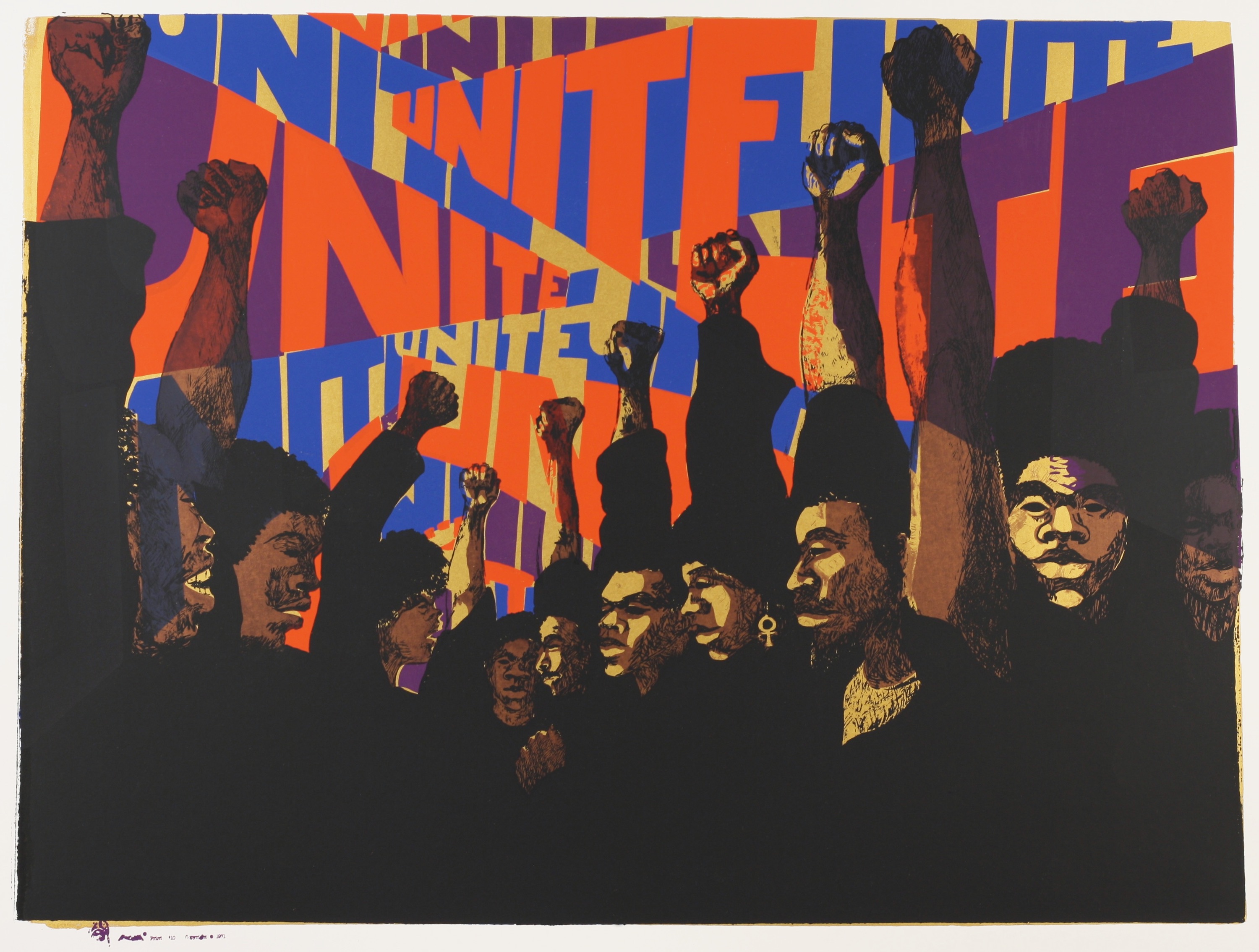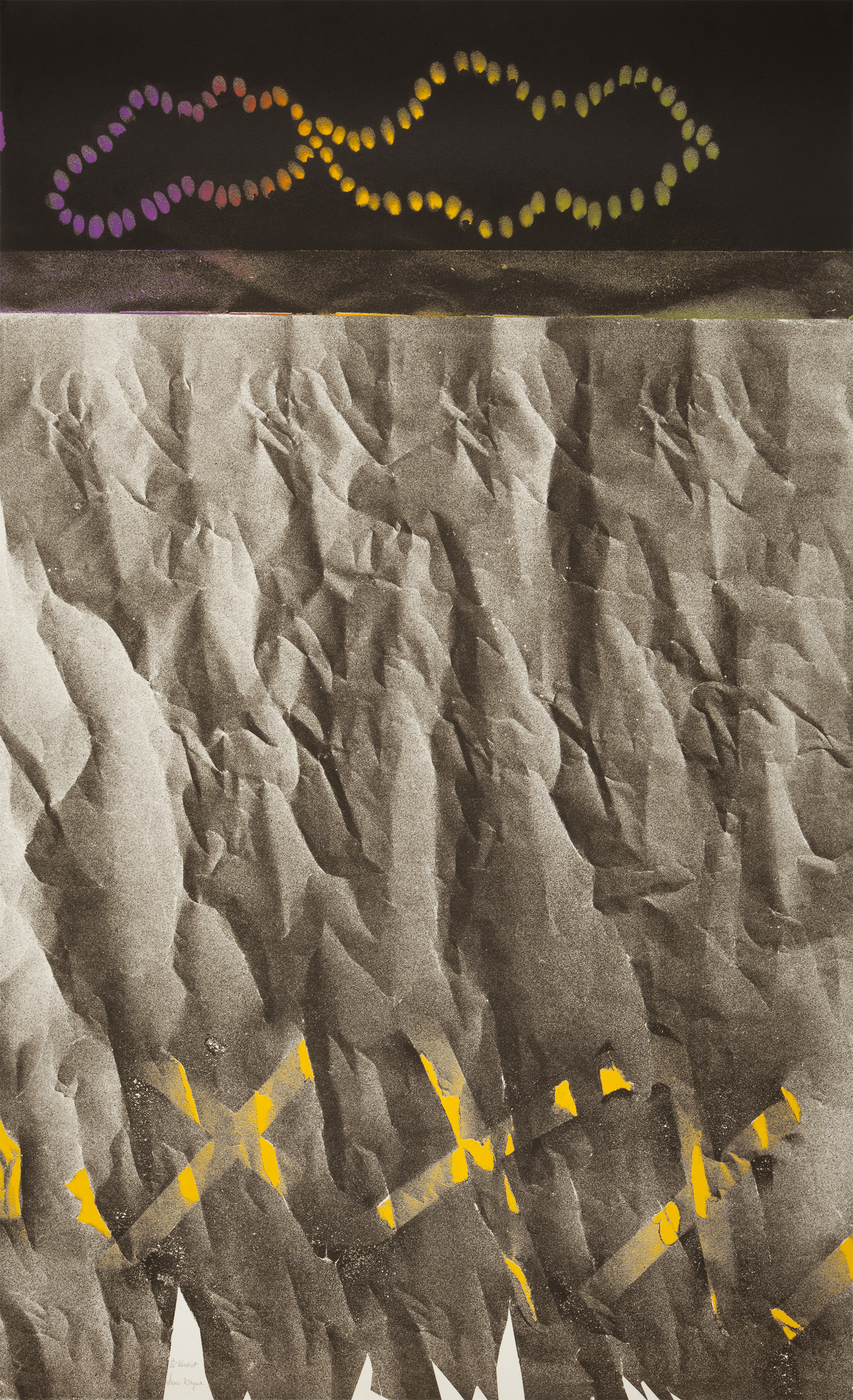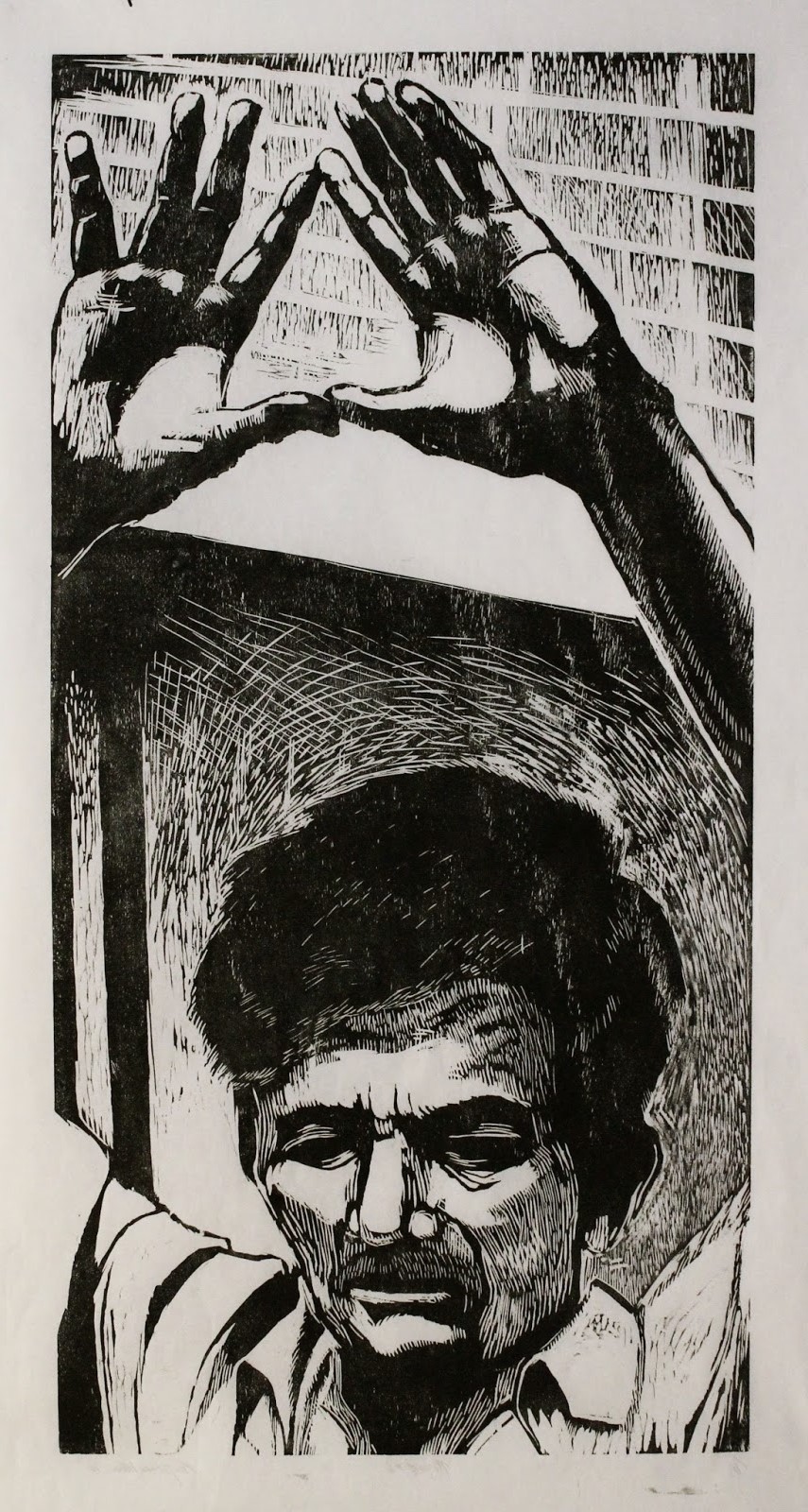 Barbara Jones-Hogu's "Unite." (Collection of the artist/Courtesy of Lusenhop Fine Art/Copyright David Lusenhop)
Barbara Jones-Hogu's "Unite." (Collection of the artist/Courtesy of Lusenhop Fine Art/Copyright David Lusenhop)CHICAGO — Printed works from various artists will be on display at
DePaul Art Museum this winter. Three exhibitions will include works by lithographers
Clinton Adams and June Wayne of the Tamarind Institute, as well as by Chicago
artists Barbara Jones-Hogu and Jose Guerrero, from the city’s South Side and
Pilsen neighborhood, respectively. The exhibitions open Jan. 11 and run through
March 25, 2018, at the museum on DePaul University’s Lincoln Park Campus.
“Throughout the 20th century, printmaking has been embraced for
its ability to reproduce images, but it has also been seen as less valuable
than painting or sculpture in the art market for the same reason,” said Julie
Rodrigues Widholm, director and chief curator of the museum.
“DePaul Art Museum is interested in bringing under-recognized or
overlooked artists and art forms into the program, and we wanted to explore the
vitality of printmaking then and now in these exhibitions,” Widholm said.
Rock,
Paper, Image: Lithographs by Clinton Adams and June Wayne from the Belverd and
Marian Needles Collection
Clinton Adams and June Wayne are widely credited with reviving
interest in lithography in the mid-20th century. As co-founders of the Tamarind
Institute, a center for lithography based in Albuquerque, New Mexico, they
instructed artists and shared innovative techniques while simultaneously
pursuing their own independent practices.
 June Claire Wayne's "Verdict." (Collection of DePaul Art Museum/Gift of Robert Conway)
June Claire Wayne's "Verdict." (Collection of DePaul Art Museum/Gift of Robert Conway)This exhibition presents a selection of both artists’ work from
the 1950s through the 1990s, showcasing how their approaches to subjects,
ranging from landscapes and color to literature and politics, evolved over
time.
“Rock, Paper, Image” will feature over 30 lithographs, an art form
made by drawing a design on a stone or metal surface using a waxy, oily
substance that repels water but absorbs ink, allowing the image to be
transferred to paper, said Mia Lopez, the museum’s assistant curator. However,
due to the complex process and the high price of stones required for printing, lithographs
had declined in popularity before Adams and Wayne began the Tamarind Institute,
she noted.
Adams is best known for his work in modernist abstraction, with an
emphasis on the Southwestern landscape. Wayne’s work shows an interest in
science, natural phenomena, the cosmos, genes and social justice. She was feminist
and a strong advocate for women artists, said Lopez.
One of the exhibition’s highpoints is a color lithograph of a
fingerprint by Wayne titled “Visa (State 1).”
“Wayne was interested in surveillance and the idea that a
fingerprint carries so much data,” said Lopez. “It’s both a unique symbol of
individuality and a tool that can be used to identify and track people. In this
print, Wayne’s fingerprint is enlarged to an unfamiliar scale. No longer
recognizable as an extension of the body, the print maintains an aesthetic
relationship to nature, suggesting a terrain or X-ray.”
Another highpoint is Adams’ “Canyon,” which is an abstract color
lithograph that uses orange, green and yellow and is reflective of the
topography of the Southwest.
“’Canyon’ is a strong example of how Adams combined his interests
in the landscapes of the Southwest with abstraction, and also demonstrates his
skillful ability to render texture through color lithography,” said Lopez.
One of the galleries in the exhibition will explore Chicago print
studios, highlighting different types of printmaking that occurs in the city
today. Represented studios and collectives will include Spudnik Press,
Instituto Grafico de Chicago and Hoofprint Workshop.
A portion of the exhibition is from the museum’s collection, while
the rest is on loan from the personal collection of Belverd Needles Jr. and
Marian Powers. Needles and Powers have recently made a gift of 15 prints to the
DePaul Art Museum collection, including works by Adams and Wayne. Needles, a professor
of accountancy in DePaul’s Driehaus College of Business, is an internationally
recognized expert in international financial reporting and auditing. Powers is
an adjunct professor of executive education in Northwestern University’s
Kellogg School of Management. DPAM director Julie Rodrigues Widholm and
assistant curator Mia Lopez curated the exhibition.
Barbara
Jones-Hogu: Resist, Relate, Unite 1968-1975
The first solo museum exhibition by Barbara Jones-Hogu, who died
Nov. 14, 2017, features works on paper including woodcuts, etchings,
lithographs and screen prints. Jones-Hogu, a founding member of the African
Commune of Bad Relevant Artists (AfriCOBRA) and a central figure of the Black
Arts Movement, was a Chicago-based artist, filmmaker and educator. She was a
contributor to Chicago’s “Wall of Respect” mural, which celebrated its 50th
anniversary in 2017.
With AfriCOBRA, Jones-Hogu shaped the aesthetic philosophy of the
organization and was instrumental in developing the group’s signature use of
text in their works, according to Lopez. Jones-Hogu was committed to promoting
positive images that could inspire and uplift the Black community, using her
art to advocate for racial equality and empowerment, said Lopez.
The exhibition boasts over 20 pieces and includes Jones-Hogu’s
print work from 1968-75 as well as screen prints and sketches, ranging from
black-and-white images to colorful works.
“Her print work from the late 1960s and early 1970s is incredibly
colorful and graphic but is also infused with political commentary about racism
and positive messages about African-American communities and creativity,” said
Widholm.
One of Jones-Hogu’s most famous works of art is a screen print on
paper titled “Unite.” The work was made in 1971 and features several
African-American persons holding their clinched fists in the air with the word
unite written out repeatedly.
“’Unite’ illustrates the impact that current events and the black
power movement had on the artist and her work,” said Lopez.
“Barbara Jones-Hogu: Resist, Relate, Unite 1968-1975” is part of
Art Design Chicago, an exploration of Chicago’s art and design legacy, an
initiative of the Terra Foundation for American Art with presenting partner The
Richard H. Driehaus Foundation. The “Barbara Jones-Hogu: Resist, Relate, Unite
1968-1975” catalog is funded by the Terra Foundation for American Art and The
Richard H. Driehaus Foundation. DPAM director Julie Rodrigues Widholm and
assistant curator Mia Lopez curated the exhibition.
Jose
Guerrero, Presente: A Memorial Print Portfolio
 John Pitman Weber's "Migrant." (Courtesy of the artist/Collection of DePaul Art Museum/Gift of John Pitman Weber and Hector Duarte)
John Pitman Weber's "Migrant." (Courtesy of the artist/Collection of DePaul Art Museum/Gift of John Pitman Weber and Hector Duarte)Jose Guerrero, who died in 2015, was an artist and leader who influenced
his community through printmaking, mural painting and activism. He is best known
for his work in Chicago’s Pilsen neighborhood, where his studio and workshop
was a hub for art classes, mural tours and political organizing.
The exhibition “Jose Guerrero, Presente” features a portfolio of
prints made in his memory by 25 Chicago artists, as well as some of his own
works on paper.
Artists include: Montserrat Alsina, Rene Arceo, Cathy Cajandig, Vicky Cervantes, Héctor Duarte, Nicolas De Jesus, Roberto Ferreyra, Eric Garcia, José L Gutierrez, Salvador Jimenes, Alexy Lanza, Edgar Lopez, Alfredo Martinez, Dolores Mercado, Luis Montenegro, José L Pina Morales, Oscar Moya, Art Olson, Antonio Pazaran, Katherine Perryman, Eufemio Pulido, Erik Salgado, Diana Solis, Benjamin Varela, Gabriel Villa and John Pitman Weber.
A native of San Antonio, Texas, Guerrero moved to Chicago in 1964.
He was a popular artist who infused activism and political organizing into
community art making by opening his own print studio and leading mural tours in
the Pilsen neighborhood, teaching people about the symbols and meaning behind
cultural imagery, explained Lopez.
Included in the 26-piece portfolio by Guerrero’s students,
colleagues and friends are screen prints, woodcuts and linocuts. Themes that were
central to Guerrero’s artistic practice and life’s work, including labor
rights, displacement and gentrification, immigrant’s rights and social equality,
are expressed in the collection.
An iconic image in the exhibition is a linocut titled “Migrant” by
Weber, founder of the Chicago Public Art Group. “Migrant” illustrates a man
raising his arms over his head in a moment of strife.
“Weber was a longtime collaborator of Jose Guerrero and worked on
numerous murals with him throughout Pilsen and the surrounding community,” said
Lopez. “In ‘Migrant’ he speaks to his and Guerrero’s shared concern for human
rights and the struggles of the working class.”
Weber and Duarte organized the Guerrero memorial portfolio a few
years ago. Muralist Brother Mark Elder, C.M., an adjunct faculty member in
DePaul’s art, media and design program, facilitated the donation and exhibition
of the work. Assistant curator Mia Lopez organized the exhibition at DPAM.
DePaul Art Museum is located at 935 W. Fullerton Ave. Hours are 11
a.m. to 7 p.m. Wednesday and Thursday; 11 a.m. to 5 p.m. Friday, Saturday and
Sunday. The museum is closed Monday and Tuesday. Admission is free. Additional
information at http://museums.depaul.edu or
773-325-7506.
###
Sources:
Julie Rodrigues Widholm
julie.widholm@depaul.edu
773-325-7229
Mia Lopez
mia.lopez@depaul.edu
773-325-7599
Media
Contact:
Russell Dorn
rdorn@depaul.edu
312-362-7128